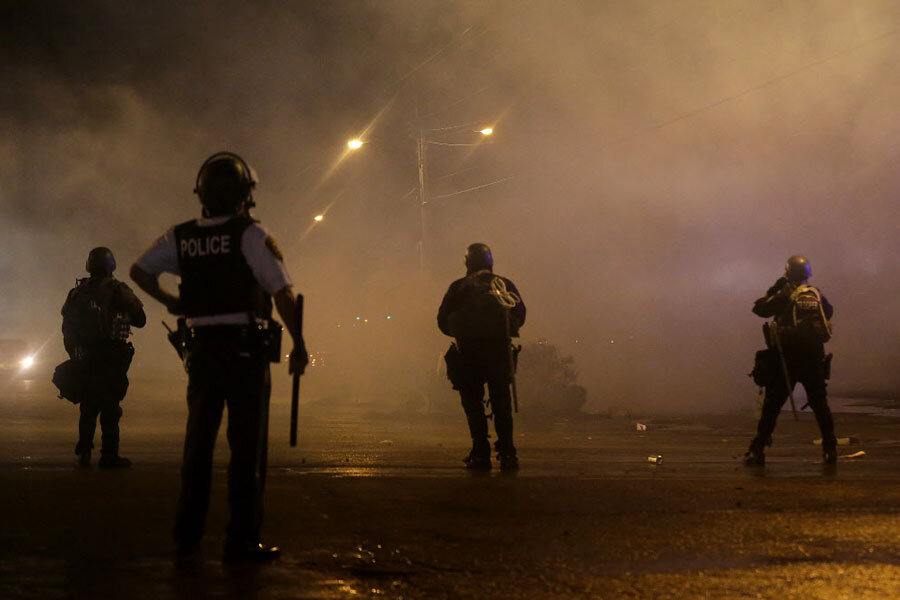Ferguson: Highway patrol uses tear gas to disperse curfew violators
Loading...
The first night of a state-imposed curfew in Ferguson, Missouri, ended with tear gas and arrests of some protesters, but it wasn't the curfew violation that precipitated the confrontation.
A team of officers from the Missouri State Highway Patrol, St. Louis city and county police moved armored vehicles down the street of the St. Louis suburb just after the midnight curfew Sunday. It turned out the timing was coincidental, said patrol Capt. Ron Johnson.
Police received a report that people broke into Red's Barbecue and some were on the roof — creating a potential danger for officers trying to disperse the protesters. Police were responding to that report — not the fact that protesters were still on the street after curfew, Johnson said.
Things got worse when a man with a handgun went into the street as police were nearing the restaurant. He ran away, but there was plenty of violence.
A man was shot and critically wounded in the same area. Police were searching for the shooter. Someone shot at a police car — it wasn't clear if it was hit.
"I was disappointed in the actions of tonight," Johnson said.
Police used smoke and tear gas on protesters who refused to move back, essentially ending the confrontation nearly an hour after the midnight curfew. Seven people were arrested for failure to disperse.
Saturday marked a week since a white Ferguson officer, Darren Wilson, shot and killed 18-year-old Michael Brown on Aug. 9. The shooting ignited racial tension in the mostly-black suburb and has led to looting and several run-ins between police and protesters.
As the curfew deadline arrived Sunday, remaining protesters — chanting "No justice! No curfew!" — refused to leave the area. And as five armored tactical vehicles approached the crowd, officers spoke through a loudspeaker: "You are in violation of a state-imposed curfew. You must disperse immediately. Failure to comply, may result in arrest."
As officers put on gas masks, a chant from the distant crowd emerged: "We have the right to assemble peacefully."
A moment later, police began firing canisters into the crowd of protesters.
Highway Patrol Spokesman Lt. John Hotz initially said police only used smoke, but later told The Associated Press that they also fired tear gas canisters. He said of police efforts: "Obviously, we're trying to give them every opportunity to comply with the curfew."
Jayson Ross, who was leading the protesters toward police before the canisters were fired, said: "They got guns. We got guns. We are ready."
The unrest between police and protesters came after Gov. Jay Nixon on Saturday declared a state of emergency in Ferguson.
Nixon's curfew announcement came after tensions again flared in Ferguson late Friday night. Earlier that day, local police identified the officer who shot Brown as Darren Wilson and released documents and video footage alleging that Brown had robbed a convenience store just before he was shot. Police said Wilson was unaware Brown was a suspect when he encountered him walking in the street with a friend.
In announcing the curfew, Nixon said that though many protesters were making themselves heard peacefully, the state would not allow looters to endanger the community.
"I am committed to making sure the forces of peace and justice prevail," Nixon said during a press conference at a church that was interrupted repeatedly by people objecting to the curfew and demanding that the officer who shot Brown be charged with murder.
"We must first have and maintain peace. This is a test. The eyes of the world are watching," Nixon said. "We cannot allow the ill will of the few to undermine the good will of the many."
State statute gives the governor broad powers when he declares a state of emergency, but he hasn't indicated that he plans to do anything other than imposing the curfew and empowering the state highway patrol to enforce it.
Meanwhile, Nixon said the U.S. Department of Justice is beefing up its civil rights investigation of the shooting.
Missouri State Highway Patrol Capt. Ron Johnson, who is in charge of security in Ferguson, said 40 FBI agents were going door-to-door in the neighborhood starting Saturday, talking to people who might have seen or have information about the shooting.
Johnson on Saturday said police would not enforce the curfew with armored trucks and tear gas but would communicate with protesters and give them ample opportunity to leave. Local officers faced strong criticism earlier in the week for their use of tear gas and rubber bullets against protesters. Johnson said one tear gas canister was deployed Friday night after the group of rioters became unruly and several officers got trapped and injured.
Brown's death had already ignited several days of clashes with furious protesters. Tensions eased Thursday after Nixon turned oversight of the protests over to the Missouri Highway Patrol. Gone were the police in riot gear and armored vehicles, replaced by the new patrol commander who personally walked through the streets with demonstrators. But Friday night marked a resurgence of unrest.
On Saturday, some residents said it appeared the violent acts were being committed by people who came from other suburbs or states.
Wilson, the officer who shot Brown, is a six-year police veteran who had no previous complaints against him, the local police chief has said.
The Ferguson Police Department has refused to say anything about Wilson's whereabouts, and Associated Press reporters were unable to contact him at any addresses or phone numbers listed under that name in the St. Louis area.
Wilson has been on paid administrative leave since the shooting. St. Louis County prosecutor Bob McCulloch said it could be weeks before the investigation wraps up.
___







